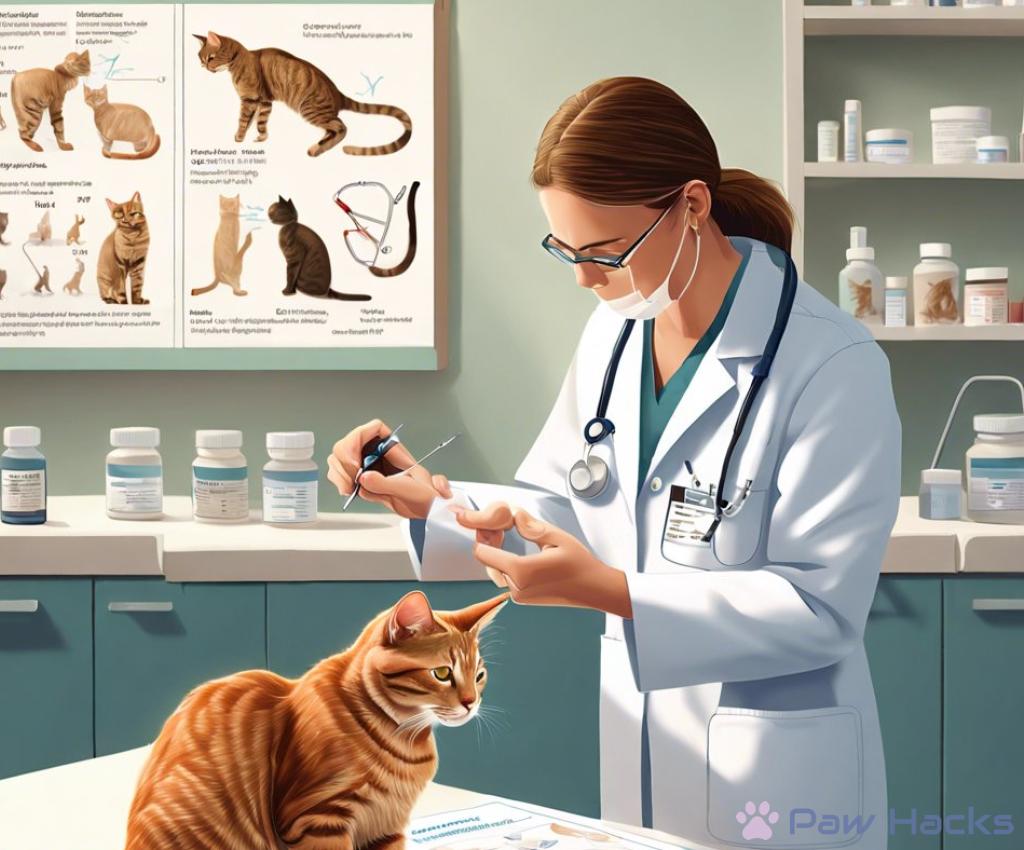Feline Arthritis Pain Management
Understanding Feline Arthritis: Symptoms and Diagnosis

Arthritis in cats is a condition that often goes unnoticed until it has progressed significantly. As pet owners, it’s crucial to be vigilant about any changes in your feline friend’s behavior and mobility. Early detection can lead to more effective management and improved quality of life for your cat.
Common symptoms of feline arthritis include:
- Reduced Activity: Cats may become less active and prefer to rest more.
- Difficulty Jumping: If your cat struggles to jump onto furniture or climb stairs, it could be a sign of arthritis.
- Changes in Grooming Habits: Cats may groom less or stop grooming certain areas due to pain.
- Behavioral Changes: Increased irritability or withdrawal from social interactions can indicate discomfort.
Diagnosis of feline arthritis typically involves a combination of physical examinations, medical history, and imaging tests. Veterinarians look for specific signs that might indicate joint pain or discomfort. Here’s how the process generally unfolds:
- Veterinary Examination: The vet will conduct a thorough examination, checking for swelling or pain in the joints.
- Medical History: Owners should provide information about any observed changes in behavior or mobility.
- X-rays: Radiographs can help visualize joint changes and confirm the presence of arthritis.
Feline arthritis can significantly affect a cat’s quality of life. Understanding the symptoms and diagnosis is the first step towards effective management. Here’s a brief overview of the impact:
| Aspect | Impact of Arthritis |
|---|---|
| Mobility | Reduced ability to move freely |
| Comfort | Increased pain and discomfort during daily activities |
| Behavior | Changes in social behavior and grooming habits |
By recognizing the symptoms and understanding the diagnosis process, pet owners can work closely with veterinarians to create a tailored pain management plan for their beloved cats. Early intervention can lead to better outcomes and a more comfortable life for our feline companions.
Effective Home Remedies for Managing Your Cat’s Arthritis Pain
As a devoted cat owner, witnessing your furry companion battle arthritis can be heart-wrenching. Fortunately, there are effective home remedies that can help alleviate your cat’s discomfort and improve their quality of life. These approaches can complement veterinary care and provide your cat with the relief they need to stay active and happy.
One of the most impactful ways to manage your cat’s arthritis pain is through dietary changes. Incorporating supplements such as omega-3 fatty acids can significantly support joint health. These fatty acids, often found in fish oil, help reduce inflammation and can lead to improved mobility. Additionally, you may consider switching to a diet that is rich in antioxidants and joint-supporting nutrients, as these can promote overall joint function. Always consult your veterinarian before making significant dietary changes to ensure it is suited for your cat’s specific needs.
Another effective method in managing arthritis pain involves modifying your cat’s living space to enhance their comfort. Providing soft bedding in easily accessible areas can encourage rest without placing strain on their joints. If your cat struggles with climbing, consider placing ramps or steps near their favorite spots. Maintaining a warm environment can also help alleviate stiffness, as cold can exacerbate joint pain. It’s essential to create a space that promotes relaxation and minimizes the risk of injury from slips or falls.
Furthermore, incorporating gentle exercise routines into your cat’s daily life can aid in maintaining joint flexibility. Short, frequent play sessions using interactive toys can stimulate movement without overwhelming your cat. Always pay attention to their limits and adjust the activity level accordingly to prevent overexertion.
By implementing these home remedies, you can take proactive steps in managing your cat’s arthritis pain. A combination of proper nutrition, a supportive living environment, and gentle exercise can lead to a more fulfilling life for your feline friend.
The Role of Diet and Nutrition in Feline Arthritis Care
A well-balanced diet is a cornerstone of managing feline arthritis. Just like humans, cats benefit from specific nutrients that support joint health and overall well-being. Pet owners should be aware that what goes into their cat’s bowl can make a significant difference in how they cope with arthritis pain. Optimizing nutrition can not only help manage symptoms but also enhance your cat’s quality of life.
When it comes to choosing the right diet for your arthritic feline, certain nutrients stand out as particularly beneficial. Below is a list of essential dietary components that can help support your cat’s joint health:
- Omega-3 Fatty Acids: Found in fish oil, these fatty acids have anti-inflammatory properties that can reduce joint inflammation and pain.
- Antioxidants: Vitamins C and E help combat oxidative stress, which can worsen inflammation. Foods rich in these vitamins can be a great addition to your cat’s diet.
- Glucosamine and Chondroitin: These supplements promote cartilage health and can be found in specific cat foods designed for joint support.
- High-Quality Proteins: Essential for maintaining muscle mass, which supports joint function, high-quality protein sources should be prioritized.
Every cat is unique, and their dietary requirements may vary depending on their age, weight, and overall health. It is crucial to consult with a veterinarian to create a personalized diet plan that addresses your cat’s specific needs. Your vet can provide guidance on appropriate portions and recommend high-quality commercial diets or homemade meals that are suitable for arthritic cats.
In addition to tailored diets, consider feeding your cat smaller, more frequent meals to help manage their weight. Excess weight can put additional strain on their joints, exacerbating arthritis symptoms. By taking a proactive approach to your cat’s nutrition, you can significantly contribute to their comfort and mobility.
Exploring Veterinary Treatments for Feline Arthritis Relief
When managing feline arthritis, it is essential to consider the various veterinary treatments available that can help alleviate pain and enhance your cat’s quality of life. While home remedies and dietary adjustments play a significant role, professional veterinary interventions can provide targeted relief. Understanding the options can empower pet owners to make informed decisions for their furry companions.
Veterinarians often prescribe medications specifically designed to manage arthritis pain in cats. These can include non-steroidal anti-inflammatory drugs (NSAIDs) that help reduce inflammation and discomfort. It is critical to follow your vet’s guidelines regarding dosage and frequency, as improper use can lead to adverse effects.
In cases where oral medications may not suffice, veterinarians may recommend joint injections. These injections can deliver corticosteroids or hyaluronic acid directly into the affected joints, providing swift relief from inflammation and pain. This targeted approach can significantly enhance mobility and comfort. Additionally, physical therapy can be beneficial, involving exercises and treatments designed to strengthen muscles and improve joint function.
Beyond conventional medications, alternative therapies are gaining popularity in managing feline arthritis. Options such as acupuncture and laser therapy have shown promising results in reducing pain and improving the overall well-being of arthritic cats. These methods can complement traditional treatments and offer a holistic approach to pain management. Always consult your veterinarian before starting any alternative therapies to ensure they are appropriate for your cat’s condition.
By exploring the various veterinary treatments available for feline arthritis, pet owners can create a comprehensive pain management plan tailored to their cat’s specific needs. The combination of medication, targeted therapies, and alternative treatments can lead to significant improvements in your cat’s comfort and mobility, allowing them to enjoy their daily activities once again.
Creating a Comfortable Living Space for Your Arthritic Cat
When your beloved feline companion is battling arthritis, their living space plays a critical role in their comfort and well-being. A carefully crafted environment can significantly ease their pain and encourage mobility. The goal is to create a sanctuary where your cat feels safe, relaxed, and supported. Here are some effective strategies to transform your home into a haven for your arthritic cat.
Your cat’s comfort starts with the places they choose to rest. Providing soft, supportive bedding in easily accessible locations is essential. Cats with arthritis may struggle to jump or climb, so consider placing beds at ground level or in low furniture. Ensure that these resting spots are away from drafts and noise, creating a peaceful retreat. Additionally, you might want to use orthopedic pet beds designed to support their joints.
Reducing the physical strain on your cat can significantly improve their quality of life. Incorporating ramps or steps can help them navigate their environment without the need for jumping. These devices can be placed near favorite spots—like windowsills or couches—enabling your cat to access these areas comfortably. Below is a comparison of various mobility aids to consider:
| Mobility Aid | Benefits | Considerations |
|---|---|---|
| Ramps | Ease of access to higher surfaces | Must be sturdy and secure |
| Steps | Allows gradual elevation | Height should be manageable for your cat |
| Grippy Mats | Enhances traction on slippery surfaces | Should be easy to clean |
Temperature can greatly affect arthritic joints. Keeping your home warm can help alleviate stiffness and discomfort. Consider using heated pet beds or blankets to provide additional warmth. It’s also essential to declutter your living space to minimize the risk of falls or injuries. By ensuring a clear path for your cat, you reduce the chances of accidents, allowing them to move freely without fear.
In conclusion, by focusing on these aspects of your cat’s living environment, you can create a space that not only accommodates their needs but also enhances their overall well-being. With careful planning and thoughtful modifications, your furry friend can enjoy a more comfortable and fulfilling life despite the challenges of arthritis.
Share this content:



